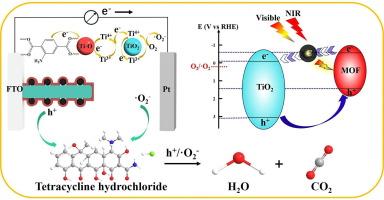当前位置:
X-MOL 学术
›
Sep. Purif. Technol.
›
论文详情
Our official English website, www.x-mol.net, welcomes your
feedback! (Note: you will need to create a separate account there.)
Ultrathin metal–organic framework synergizes with carbon quantum dots improving photoelectrochemical water oxidation and tetracycline hydrochloride degradation performance
Separation and Purification Technology ( IF 8.1 ) Pub Date : 2024-11-17 , DOI: 10.1016/j.seppur.2024.130589 Ruyi Wang, Xingzhi Li, Yuxin Kan, Wenjun Fang, Caiyun Chen, Yongyan Chen, Lingling Wang, Yong Jia
Separation and Purification Technology ( IF 8.1 ) Pub Date : 2024-11-17 , DOI: 10.1016/j.seppur.2024.130589 Ruyi Wang, Xingzhi Li, Yuxin Kan, Wenjun Fang, Caiyun Chen, Yongyan Chen, Lingling Wang, Yong Jia

|
Finding clean dual functional materials which can simultaneously alleviate energy and environmental issues is currently a research hotspot. In our work, TiO2/CQDs/NH2-MIL-125 photoanode system was constructed to explore the application of metal–organic frameworks (MOFs) materials in water splitting and biomedical wastewater treatment. The photocurrent density of the optimal TiO2/CQDs/NH2-MIL-125 photoanode reaches 1.7 mA/cm2 at 1.23 V vs. RHE, which is about 1.8 times that of pristine TiO2. More importantly, optimized photoanode displays an excellent remove ratio toward tetracycline hydrochloride of 74 % within 60 min. Through mechanism exploration, the excellent performance is attributed to the narrow band gap of NH2-MIL-125 widens the light absorption range to the visible region. Additionally, the specific electron conduction behavior of CQDs and the type Ⅱ heterojunction between TiO2/NH2-MIL-125 inhibited the photogenerated electron-hole recombination. This work explores the application of photoelectrochemical (PEC) materials in environmental catalytic clean production.
中文翻译:

超薄金属-有机框架与碳量子点协同作用,提高光电化学水氧化和盐酸四环素降解性能
寻找能够同时缓解能源和环境问题的清洁双功能材料是目前的研究热点。在我们的工作中,构建了 TiO2/CQDs/NH 2-MIL-125 光阳极系统,以探索金属有机框架 (MOF) 材料在分解水和生物医学废水处理中的应用。与 RHE 相比,最佳 TiO2/CQDs/NH 2-MIL-125 光阳极在 1.23 V 下的光电流密度达到 1.7 mA/cm2,约为原始 TiO2 的 1.8 倍。更重要的是,优化的光阳极在 60 分钟内对盐酸四环素的去除率高达 74%。通过机理探索,NH 2-MIL-125 的窄带隙将光吸收范围扩大到可见光区域,从而获得了优异的性能。此外,CQDs 的特异性电子传导行为和 TiO2/NH 2-MIL-125 之间的 II. 型异质结抑制了光生电子-空穴复合。本工作探讨了光电化学 (PEC) 材料在环境催化清洁生产中的应用。
更新日期:2024-11-18
中文翻译:

超薄金属-有机框架与碳量子点协同作用,提高光电化学水氧化和盐酸四环素降解性能
寻找能够同时缓解能源和环境问题的清洁双功能材料是目前的研究热点。在我们的工作中,构建了 TiO2/CQDs/NH 2-MIL-125 光阳极系统,以探索金属有机框架 (MOF) 材料在分解水和生物医学废水处理中的应用。与 RHE 相比,最佳 TiO2/CQDs/NH 2-MIL-125 光阳极在 1.23 V 下的光电流密度达到 1.7 mA/cm2,约为原始 TiO2 的 1.8 倍。更重要的是,优化的光阳极在 60 分钟内对盐酸四环素的去除率高达 74%。通过机理探索,NH 2-MIL-125 的窄带隙将光吸收范围扩大到可见光区域,从而获得了优异的性能。此外,CQDs 的特异性电子传导行为和 TiO2/NH 2-MIL-125 之间的 II. 型异质结抑制了光生电子-空穴复合。本工作探讨了光电化学 (PEC) 材料在环境催化清洁生产中的应用。


















































 京公网安备 11010802027423号
京公网安备 11010802027423号